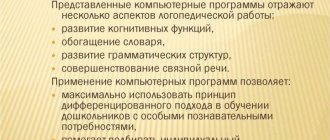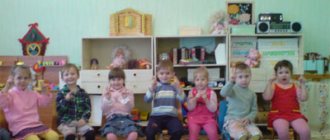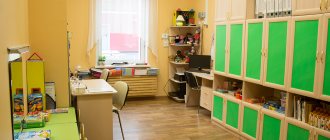Article:
Health-saving technologies are a specially organized interaction between children and teachers;
a process aimed at ensuring the physical, mental and social well-being of the child. The issue of introducing health-saving educational technologies into the work of speech therapists is becoming very relevant. Preserving and strengthening the health of children in the process of education and training is one of the most important tasks facing a speech therapist. For children with speech impairments, this is especially significant, since, as a rule, these children are somatically weakened and may have chronic diseases and disorders in the emotional and volitional sphere. Children with general speech underdevelopment are characterized by insufficient development of processes closely related to speech activity, such as auditory-verbal memory and attention, verbal-logical thinking, spatial and temporal orientation, impairment in articulation, fine motor skills and general motor skills. Many children have increased fatigue, rapid exhaustion and emotional lability. Thus, health-saving technologies in speech therapy work can significantly improve the effectiveness of correctional work, diversify the techniques and methods of speech therapy and promote the health of children, because the quality development, education and upbringing of children is impossible without attention to the preservation and promotion of health.
Tasks facing a speech therapist:
1. Increase the effectiveness of the educational process;
2. Preserve and strengthen the health of pupils;
3. Stimulate performance, promote restoration of strength, relieve tension;
4. Create a favorable psycho-emotional atmosphere, support psychological health;
5. Promote a healthy lifestyle.
The following health-saving technologies are used in speech therapy classes:
Breathing exercises
Breathing exercises play a big role in developing correct speech. They develop a long, uniform exhalation, form a strong air stream, train the ability to use air economically during speech, taking into account its addition, and train situational phrasal speech.
In parallel with this speech therapist, a number of health-improving tasks are solved, such as:
- oxygen saturation of the body
— improvement of metabolic processes
- normalization of psycho-emotional state
- increased immunity
Interest in breathing exercises is supported by a combination of visualization, game techniques, poetic forms, and attributes. Breathing exercises at the beginning of the lesson activates attention, reduces excessive emotional and motor activity, creates a positive emotional background, ensuring a smooth transition to the correction process.
Gymnastics for the eyes
A set of exercises aimed at preventing visual impairment, helps relieve tension and relax the eye muscles, strengthens the eye muscles. They also:
-develop concentration
- provide interhemispheric interaction
- develop volitional regulation skills and the ability to control movements
-improves accommodation
Exercises such as “Running lights”, “Sunny bunnies”, etc. during written assignments, after a long visual load, are a good pause for rest, help reduce tension on the eye muscles, and develop visual attention. In combination with tasks on spatial orientation (“Where will the path lead”, etc.) do they help solve another very important problem? development of optical-spatial concepts.
Development of fine motor skills of the hands. (Finger gymnastics)
Fine motor skills and the level of speech development are directly dependent on each other. Therefore, targeted work on the development of hand motor skills directly affects speech development, making it easier for the child to correct speech disorders. Depending on the goal, relaxing, static and dynamic exercises are used. What is important, not only in speech therapy classes, but also in independent activities, these exercises prepare the hand for writing, help relieve tension, especially after prolonged exercise, and develop manual skills.
In speech therapy classes there is a fairly wide range of use of finger and hand games. This is the most convenient type of task at the stage of automating sound pronunciation, allowing you to diversify the work, make it interesting for the child, avoid unnecessary stress, while maintaining interest in the correction process.
When working on the prosodic side of speech, the dialogical form of coherent speech, it is advisable to use small finger toys that create a positive emotional background, help relieve tension in the lesson, stimulate speech activity, introducing elements of theatrical activity into the lesson.
Speech therapy rhythm.
Logorhythmics as a special science is an important component in the correctional work of a speech therapist. It is a unique form of active therapy, a means of influence in a complex of techniques, a synthesis of music, words and movement. It is no coincidence that, along with educational and correctional tasks, health-improving tasks stand out. As a result of solving health-improving tasks, people with speech disorders strengthen the musculoskeletal system, develop breathing, motor, sensory functions, develop a sense of balance, correct posture, gait, grace of movements (G.A. Volkova)
Logorhythmics is useful for children with speech delays, alalia, sound pronunciation disorders, stuttering, and autistic disorders. Speech therapy rhythm is very important for children with so-called speech negativism, since classes create a positive emotional mood for speech, motivation to perform speech therapy exercises, etc.
Self-massage. Su-Jok therapy. Auricolo therapy.
In speech therapy work, new therapeutic and health techniques are becoming increasingly popular, which are quite effective, safe and easy to use, and also successfully complement speech correction work.
According to the concept of microacupuncture systems of the body, on the skin of the ears, palms and soles, all parts of the body and organs are represented, the dysfunction of which leads to disruption of the sensitivity of the corresponding zones on the skin. Massage of these zones allows you to “wake up” inhibited and inhibit excited biologically active points, which significantly affects the general condition of the child.
Stimulation of highly active acupuncture points located on the fingers using various devices (balls, massage balls, prickly rollers, nuts, etc. When stimulating receptors in the muscles, impulses arise that reach the cerebral cortex, tone the central nervous system, resulting in an increased regulatory role in the central nervous system in regarding the functioning of all systems and organs.
The combination of exercises such as self-massage, su-jok therapy, with exercises for correcting sound pronunciation and the formation of lexical and grammatical categories, can significantly increase the effectiveness of correctional speech therapy, increasing physical and mental performance.
The system of influencing the area of the auricles, through a light massage (pressure, rubbing, stroking), has a general strengthening effect, improves blood circulation, stimulates the activity of nerve centers, increases tone, and activates attention. It is most effective to use these exercises in the morning, preceding a speech therapy session.
Kinesiological exercises for the development of interhemispheric interaction
Any mental function is carried out by the joint work of two hemispheres, each of which makes its own personal contribution to the construction of mental processes. Coordination and interaction of the cerebral hemispheres is a necessary condition for the success of any activity. (B.G. Ananyev)
This type of exercise is aimed at the formation and development of interhemispheric interaction, the development of accuracy of finger movement and the ability to switch from one movement to another (“Fist-rib-palm”, “Ear-nose”, “Ring”, “Frog”, “Lock” and etc.). They are equally well suited for working with children with speech pathology and with children without speech disorders, as they solve a number of important problems:
-development of specialization of the cerebral hemispheres;
-synchronization of the cerebral hemispheres;
-development of thinking, memory, attention;
-development of the ability for voluntary control;
-relieving psycho-emotional stress;
In relation to speech therapy work, it is advisable to use this type of exercise to activate attention at the beginning of a lesson, during a change of activity, as well as dynamic pauses or at the end of a lesson, to relieve tension and help the child switch to another type of activity.
In children with OHP, insufficient development of spatial gnosis is often determined; in this case, these exercises are included in the plan of individual work with such children and are given for reinforcement in a group with a teacher.
THAT. health technologies in the educational process are introduced in a health-preserving and health-developing environment that provides a favorable hygienic, psychological and pedagogical environment. Only a complex impact on a child can provide successful dynamics of speech development and social adaptation. The use of health-saving technologies in work increases the effectiveness of the educational process, forms in teachers and parents value orientations aimed at preserving and strengthening health, and creates motivation for a healthy lifestyle.
Health-saving technologies in the work of a speech therapist
Annotation:
The relevance of the health-preserving direction in the system of methodological work of preschool educational institutions is confirmed by a number of the following contradictions:
- the contradiction between the increased need for a teacher with deep knowledge of health-saving approaches, technologies and the insufficient development of the scientific foundations of the problem of health-saving;
- the contradiction between the large reserve of health-saving technologies in the educational process and the insufficient implementation of these opportunities;
- high level of requirements for children's health and limited capabilities of teaching staff to create a health-preserving environment.
Health-saving technologies in the work of a speech therapist.
Preschool childhood is a valuable stage in life, and not just preparation for school. It is necessary to develop curiosity and inquisitiveness, cognitive interest in children, so that the child approaches school with the motivation: “I want to learn!” This can be achieved only by maintaining and strengthening the health of preschool children.
That is why I define the health-saving aspect of the educational process as one of the priority areas of my activity.
Health preservation as a necessary aspect of complex rehabilitation of children with speech pathology.
The concept of “health-saving technologies”.
At the present stage, health-saving technology is defined as a system of measures that includes the interrelation and interaction of all factors of the educational environment aimed at preserving the health of a child at all stages of his learning and development.
There are different opinions, different concepts that define the content of health-saving technologies. But when you first hear the combination “health-saving technologies” and remember your little pupils, your own definition is formed in your head.
Health-saving educational technologies can be defined as the science, art and responsibility of teaching and raising children so that they grow up healthy and happy and can then raise their children healthy and happy, being worthy of them.
Objectives of correctional and developmental work with the introduction of health-saving technologies.
- increasing mental and physical performance;
- protecting the nervous system, relieving mental and nervous tension;
- stimulation of speech areas of the cerebral cortex;
- formation of oral praxis;
- improvement of gross, fine motor skills and visual-spatial gnosis;
- increasing the reserves of the respiratory system;
- prevention of visual impairment;
- creating a favorable emotional background.
When using health-saving technologies, it is necessary to know and strictly observe the basic principles of health-saving technologies in preschool educational institutions:
- accessibility (use of health-saving technologies in accordance with the age of children);
- systematic (implementation of health-improving activities constantly);
- optimality (reasonably balanced psychophysical load);
- sequences (sequential complication and increase in load);
- complex impact on all analyzers;
- joint – pedagogical influence (teacher-speech therapist, educator, psychologist, medical personnel, parents).
And now I would like to touch on the classification of health-saving technologies in preschool educational institutions.
Modern health-saving technologies can be divided into the following types:
- Technologies for preserving and promoting health:
game stretching, eye gymnastics, development of fine motor skills and visual-spatial gnosis, kinesiological exercises, breathing exercises and breathing-voice exercises, articulation gymnastics, Su-jok therapy.
- Technologies for teaching a healthy lifestyle:
game training and game therapy, communicative games, self-massage, biofeedback (BFB, auriculotherapy.
- Corrective technologies:
art therapy, fairy tale therapy, color therapy, psycho-gymnastics, phonetic and speech therapy rhythms, water games, aromatherapy, music therapy, sand therapy, bioenergoplasty.
Organization of correctional and developmental work using health-saving technologies:
- familiarizing preschool teachers and parents with a range of health-improving activities;
- accumulation of practical material;
- preparation of annual planning;
- organization of educational activities for children using health-saving technologies;
- work with parents (consultations, workshops, conversations);
- making changes and additions to the development environment of the preschool educational institution;
- presentation with an analysis of the work done at the final pedagogical council of the preschool educational institution;
- presentation with an analysis of children’s achievements at the psychological, medical and pedagogical council of the preschool educational institution.
Methods and techniques of health-saving technologies in the process of conducting GCD.
Let's consider the methods and techniques of health-saving technologies that I use in correctional work at different stages of GCD. The first stage of GCD is organizational. Its goal is to introduce the topic of the lesson, create a positive attitude towards learning, awaken interest in knowledge, and also correct psychophysical functions. During organizational moments I include relaxation, facial expression and imitation exercises.
One of the next stages of GCD may be work on the development of the basic movements of the organs of the articulatory apparatus, which is carried out in the form of articulatory gymnastics.
It needs to be carried out emotionally, in a playful way, for example: “The Tale of a Merry Tongue”, “The Tale of a Mosquito”.
- Articulatory gymnastics can be performed not only traditionally, but in a non-traditional form:
- “Exercises for the fingers and tongue” (or related gymnastics);
- Use of didactic dolls;
- Adapted fairy tales with movements;
- Writing stories from the life of Tongue using pictures and images;
- Unconventional exercises with beads, dragees and spoons to improve articulatory motor skills.
I add brush movement to all articulation exercises. The use of bioenergoplasty effectively speeds up the correction of defective sounds in children, since the working palm repeatedly amplifies the impulses going to the cerebral cortex from the tongue.
At the main stage of GCD I use:
- breathing exercises and breathing-voice exercises.
- exercises for the development of fine motor skills and visual-spatial gnosis: - finger games according to the topics of the lessons;
- planning graphic dictations by topic;
- outlining patterns and shading according to lexical topics;
- games with simulators;
- games with pebbles; - draw grain by grain;
- exercise “Miracle - beads”; - games with clothespins, reels;
- acupressure and self-massage (su-jok therapy, auriculotherapy).
The functional anatomical immaturity of the visual system and the significant visual stress that a child’s eye experiences in the process of reading and writing necessitate the use of eye gymnastics.
Games and play exercises that are appropriately included in the GCD give the educational task a specific meaning and mobilize the child’s mental powers. Gaming technologies help solve not only problems of motivation and child development, but also health and socialization.
An excellent stimulus for children and a means of creating speech situations is the finger theater, which is in the arsenal of the speech therapy room.
In my work I widely use sand therapy and seed therapy. Developing sensory standards, in the process of sand therapy I solve typical speech problems: I develop phonemic hearing, automate assigned sounds, activate the dictionary, form coherent speech and grammatical categories, as well as fine motor skills.
When fatigue manifests itself, performance decreases, or loss of interest and attention, I include physical education minutes and speech therapy rhythmic exercises in the structure of ECD.
I use a kinesiological set of exercises. Such exercises make it possible to use those parts of the brain that were not previously involved in learning. At the final stage of the GCD, the results are summed up. A prerequisite is to remember: the child is valued, not judged! The final “chord” of the GCD should contain a positive assessment and confidence that tomorrow it will turn out even better.
Conclusion.
Dear colleagues, I have demonstrated to you the variability of using various methods and techniques of health-saving technologies aimed at strengthening and preserving the health of children. I use these techniques in my work and I can say with confidence that they have a positive effect on children: their performance increases, the quality of the educational process improves.
Thus, we can conclude that the use of health-saving technologies in educational activities contributes not only to the preservation and strengthening of the health of children with problems in speech development, but also to the improvement of the adaptive and compensatory capabilities of the child’s body.
Literature
- Akhutina, T.V. Health-saving teaching technologies: an individual-oriented approach // School of Health. 2000. T. 7. No. 2. pp. 21 – 28.
- Budyonnaya T.V. Speech therapy gymnastics. Toolkit. St. Petersburg: “Childhood-Press”, 2001
- Evdakimova E. S. Design as a health-saving technology in preschool educational institutions // Preschool educational institution management. 2004. N1.
- M. Yu. Kartushina. Logorhythmic classes in children. garden. M.:Sfera, 2003
- S. V. Konovalenko. Development of cognitive activity in children from 10 to 14 years old. Moscow, 1999
- Kuvshinova, I. A. Health conservation as a necessary aspect of complex rehabilitation of children with speech pathology [Text] / I. A. Kuvshinova. -M: 2009. (library of the journal “Speech Therapist”. Issue 6) 13 p.
- Kuchma V. R. Theory and practice of hygiene for children and adolescents at the turn of the millennium. - M., 2001.
- Kuchma V.R., Serdyukovskaya G.N., Demin A.K. Guidelines for hygiene and health protection of schoolchildren. - M., 2000.
- Leonova S.V. “Fun warm-up. A set of breathing exercises for reading poetic texts.” Speech therapist. 2004. No. 6. With. 83.
- Makhaneva M.D. Work of a preschool educational institution with a family to raise a healthy child. DOW management. 2005. N 5.
- Methodical recommendations: Health-saving technologies in secondary schools: analysis methodology, forms, methods, application experience / Ed. M. M. Bezrukikh, V. D. Sonkina. -M., 2002.
- Nazarenko L. D. Health-improving basics of physical exercises. - M., 2002.
- Pankratova I.V. Raising a healthy generation // Preschool Education Management. 2004. N1.
Bityukova I.V., speech therapist teacher
- Health-saving technologies in correctional work with preschool children
- Health-saving technologies in working with children with mental retardation
- Health-saving technologies in speech therapy
- Using the technology of joint project activities in the work of a speech therapist at a preschool educational institution
- Non-traditional pedagogical technologies in working with OHP
(No one has rated this article yet.)
Loading...






